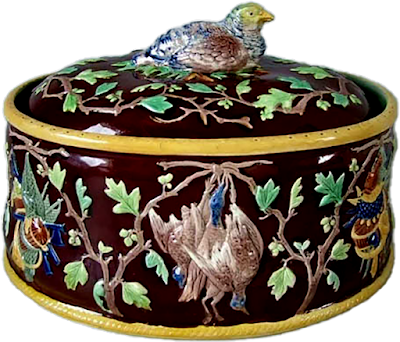We were surfing online recently and a particular piece of majolica caught our attention. It was the Oak leaf tray shown above. It presumes to be an Etruscan oak leaf tray by the Etruscan Works of Phoenixville, Pa. The GSH Oak leaf tray is one of the most commonly seen reproductions of Etruscan Majolica but this one is somehow different. Do you think it's real or a reproduction? We lay out the pros and cons for you to decide. Here is the case.
Our Take: When we examine the Etruscan mark itself something is clearly wrong. On the piece in question, shown left on the illustration below, the center logo is distorted, stretched horizontally. The condensed font used for the words "Etruscan Majolica" that compose the logo is entirely different from the one on the one on the right—there is no stress or variation to the strokes in the letters. They are generally uniform throughout. Where there is a variation, like on the letter U, the stress is on the wrong side. The slender rim on the inside of the outer seal ring is also missing.
We're sure the dealer who sold the piece assumed it was authentic but no antique dealer can know everything. We think it could have been a reasonable mistake.
Let us know what you think.
The Obverse
Con: The reason this tray caught our attention was the decoration. The colored glazes were used in a manner very different from the norm. For one thing the colors were very highly saturated and slightly different in tone and application from the trays we are used to seeing. The tray measures 12.5 inches. The average tray measures 12 inches. There are no stilt marks on the front of the tray.
Pro: At the Etruscan Works the glazes were mixed by hand over a period of eleven years. There is quite a variation of color on similarly decorated Etruscan examples. Would you say it fit well within the parameters of these variations? There was also quite a bit of variation in the size of pieces potted in Phoinixville as a result as the different clays used over the years.
Our Take: Over the years we have seen literally thousands of these leaves. We have probably personally owned 40 or 50 of them. We know this piece backwards and forwards. We have seen them in a variety of colors and conditions but we have never seen decoration this crisp and this bright. Compare it to the example below.
Right off the bat you can see that the MIS piece has an entirely different feel about it. There is a distinct difference in the colors and the application of the colored glazes. The surface of the MIS example is also much more irregular than the top example. The details of the leaf on the MIS example is less distinct, made so by the pooling of the glaze on the surface of the leaf and from the hundreds of impressions that must have been taken from the same mold. The MIS piece appears thicker and more substantial than the other as does the open handle which is unusually thin on the example in question. Although there is quite a bit of variation in the size of otherwise identical pieces, the variation is usually within a ¼ inch of 12 inches.
The Reverse
Con: The color is entirely wrong. The reverse of Etruscan majolica was done in a different color teal than that seen here, much less green and more grey. The reverse glaze usually shows a great variation in the thickness of the glaze application. This appears to be uniform. The decorators mark is missing.
Pro: The stilt marks which are commonly found on all Etruscan majolica are present on the reverse of the piece which speaks well for its authenticity. The overwhelming majority of Etruscan majolica produced, regardless if it is marked with the GSH mark or not, will have a decorator's mark like the stamped mark seen below, but there are exceptions! The piece is marked Etruscan. The example in question sold from a very reputable online site for a great deal of money. No professional dealer would risk their reputation selling a piece they knew to be a fake.
Our Take: When we examine the Etruscan mark itself something is clearly wrong. On the piece in question, shown left on the illustration below, the center logo is distorted, stretched horizontally. The condensed font used for the words "Etruscan Majolica" that compose the logo is entirely different from the one on the one on the right—there is no stress or variation to the strokes in the letters. They are generally uniform throughout. Where there is a variation, like on the letter U, the stress is on the wrong side. The slender rim on the inside of the outer seal ring is also missing.
So, what do you think?
If it is a fake it is really quite upsetting to see a copy this good. We are always on the lookout for majolica with exceptional decoration. What peaked our suspicions with this piece was the intensity, the application and the color of the glaze. It stuck out like a sore thumb as we were sifting through hundreds of similar GSH oak trays on Google Images. The reverse seal only makes us more suspicious.
Without actually examining the piece in person there is no right or wrong answer to this quiz. You need to decide for yourself whether you would purchase this piece if you saw it for sale online. When buying majolica use your head as well as your heart. If something seems off, it probably is. No one wants to be cheated. As always in antiques the burden of proof remains with the buyer.
Let us know what you think.











































































